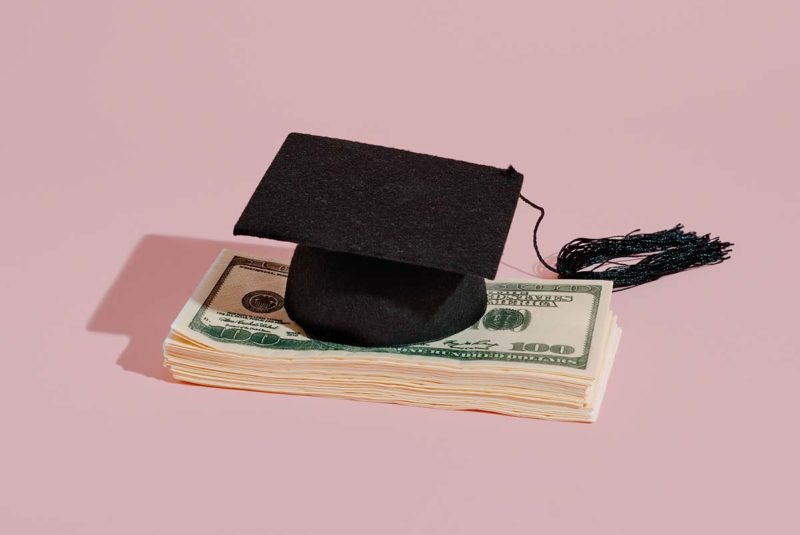Well, look at you investing in your future! According to the experts, that degree should pay off after graduation, but for now, you’re probably focused on figuring out how to pay for it all – tuition, books, dorm fees and everything in between.
Hopefully, you and your family were able to save for this day – but the cost of higher education has been going up.[1] For many aspiring graduates, the only way to cover these costs is to take out student loans – and the fun doesn’t end there. Once you graduate, you have to start paying off your student loans.
If you’re wondering how much you’ll need to pay off, you’ve probably wondered how student loan interest works.
It’s good to know because the way your interest is calculated can affect how much interest starts accruing (think: builds up) while you’re still in school. Depending on how it’s done, you may have to deal with a higher starting loan balance after you leave school. It’ll impact how much you pay each month and how long it’ll take you to pay off your student loans.
If you’re ready to get schooled on student loan interest, read on.
Student Loan Interest: Terms To Know
The SAT may no longer have a stand-alone vocabulary section, but we’ve got some key terms we need you to commit to memory.
- Principal (or outstanding principal balance): It’s the amount you borrowed or your remaining balance after making payments.
- Student loan interest rate: This is what it costs to borrow money from a lender. You normally see it expressed as a percentage.
- Interest rate factor: It’s used to calculate how much interest is charged every day. Divide the loan’s interest rate by the number of days in a year to figure it out.
- Simple interest: It’s the interest charged on the principal (see the first bullet re: principal).
- Repayment term: This is the number of years you have to pay back the loan. There are 10-, 12-, 15-, 20-, 25- and 30-year terms.
- Disbursement date: The loan money is released to you or the school on this date.
How Student Loan Interest Is Calculated
Keep those terms handy while we dive into figuring out how interest is calculated on a student loan.
Like most loans, student loans are amortized. That means you pay off your principal and the interest on the loan at the same time.
When you first start paying the loan, the bulk of your monthly payments will be applied to interest. As your outstanding principal balance gets smaller, more of your monthly payments will be applied to the loan’s principal.
In the beginning, your loan’s principal balance will go down slowly; over time, it’ll go down faster.
All federal student loans and most private loans use a simple interest formula. That means that you only pay interest on what you borrowed. If you have a car loan, you’re probably familiar with the concept of simple interest.
But are you wondering what that looks like as a formula? Say less.
Interest amount = (outstanding principal balance x interest rate factor) x number of days since last payment
How about we make it real and plug in some made-up numbers? Let’s say your outstanding principal balance is $20,000.
If your interest rate is 4.99% (which is currently the lowest federal student loan interest rate available),[2] your interest rate factor will be .0499 divided by 365, which equals 0.00013671. Multiply the interest rate factor by $20,000 and here’s how much interest you’ll be charged:
- $2.73 a day
- Around $82 per month (depending on how many days are in the month – we’re looking at you, February!)
- $996.45 a year ($999.18 on leap year)
Believe it or not, we’re getting to the good stuff now.
Now that we know how much you’ll be paying in interest on this fictional loan, we can figure out your monthly payments over the loan’s repayment term. Using a student loan interest calculator for our $20,000 loan at 3.73% interest, we get:
| Repayment Term | Monthly Payment | Total Interest Paid |
| 10 years | $212.03 | $5,443.99 |
| 12 years | $184.88 | $6,622.40 |
| 15 years | $158.05 | $8,449.82 |
With federal loans, the amount you borrow determines the length of your loan repayment plan. The maximum repayment period for our $20,000 loan is 15 years. If you borrow more money, you’ll get a longer repayment term.[3]
But no matter which term you chose with the $20,000 loan, about $62 of your first monthly payment would be applied to interest. The rest of your payment would go toward paying down the loan’s principal.
Every month, what you pay in interest would go down while the amount that gets applied to the principal would incrementally go up over the life of the loan.
When you’re deciding how long your repayment term should be, you’re weighing how much you want to pay every month against how much you’ll be charged in interest over the life of the loan.
What you’re charged in interest on your student loan will depend on who is lending the money.
Federal Loans vs. Private Student Loans
You can’t talk about student loans without making a distinction between federal student loans and private student loans.
Federal loans
In this scenario, the U.S. government is the lender, so it sets loan interest rates. Federal loans can be need-based. They are also available if you don’t qualify for federal student aid. The loans generally offer low interest rates but have strict borrowing limits.
- Types of loans: The federal government offers fixed-rate loans (think: the interest rate never changes) with simple interest.
- Interest rates: Interest rates on federal loans currently range from 4.99% interest on a Direct loan for undergrads to 7.54% interest on a Direct PLUS loan for parents and graduate or professional students.[2]
- Loan relief: Federal student loans come with a variety of loan relief options, including deferment, forbearance, income-based repayment and loan forgiveness programs.
- Consolidation options: If you have several federal student loans, you can bundle them into one federal consolidation loan or a private student loan. But in case you’re wondering, private student loans can’t be consolidated into a federal consolidation loan.
Private loans
The lender can be a bank, a credit union, an online lender or another financial institution. Interest rates and terms are set by the lender and can vary depending on the interest rates set by the federal government.
- Types of loans: Lenders offer fixed-rate, variable-rate and hybrid loans that charge simple interest or compound interest.
- Interest rates: The rates are based on current market interest rates. They can range from around 1% – 12%, depending on your credit score, income and whether the interest rate is fixed or variable.
- Loan relief: Private loans can be refinanced, and some lenders will temporarily postpone repayments under certain circumstances – but private loans aren’t eligible for loan forgiveness.
- Consolidation options: You can use private loans to consolidate both federal and private loans.
When you’re first starting out, federal loans typically offer lower interest rates. As your career takes off, if your financial situation improves and your credit is good, you may be able to get a better rate on a private loan.
FYI, a variable-rate loan may come with an attractively low interest rate at the start, but that interest rate can go up over time, which could end up costing you more in interest.
Subsidized and Unsubsidized Student Loans
Do you know who pays the interest on a federal student loan while you’re in school? The answer depends on whether the loan is a Direct subsidized loan or a Direct unsubsidized loan.[4]
Subsidized student loans
Subsidized loans don’t accumulate interest while you’re enrolled (this includes part-time students). The U.S. Department of Education covers the interest payments while you’re in school and 6 months after you leave school (aka the grace period) and if fall below half-time enrollment.
Subsidized loans are usually federal, and they’re reserved for undergraduate students who need financial aid.
If you’re eligible for a subsidized student loan, fill out a Free Application for Federal Student Aid form (commonly known as the FAFSA® form) when you start applying to schools.
Unsubsidized student loans
Most federal and private loans are unsubsidized. That means no one is covering the interest while you’re in school.
Interest accrues as soon as the lender disburses the money to you or your school. But you don’t have to pay it right away, and you still get the 6-month grace period after you leave school.
How an unsubsidized loan increases your loan balance
Let’s say you’re a full-time student at a 4-year college, and you borrow money at the start of each year:
- Loan 1: Freshman year – $5,000
- Loan 2: Sophomore year – $6,000
- Loan 3: Junior year – $7,000
- Loan 4: Senior year – $7,000
That’s a total of $25,000 over 4 years at 4% interest.
With a subsidized loan, you’d be paying off a $25,000 loan after you leave school. With an unsubsidized loan, it would look something like this:
| Loan | Loan Amount | Total # of months of interest accumulated (Years Enrolled + 6-Month Grace Period) | Total interest accumulated at 4% |
| 1 | $5,000 | 54 | $900 |
| 2 | $6,000 | 42 | $840 |
| 3 | $7,000 | 30 | $700 |
| 4 | $7,000 | 18 | $419 |
| Total | $25,000 | $2,869 |
By the time you leave school, the loan you took out your first year has been accumulating interest for 54 months (4 years / 48 months + 6-month grace period), adding $900 to your student loan balance.
Meanwhile, the $7,000 loan you took out your senior year has accumulated $419 in interest.
In 4 years, $2,869 in interest (more than 10% of the combined loans) has turned $25,000 in loans to $27,869 in loans.
If you want to get a head start on paying off interest and the option works for your budget, start paying off your student loans while you’re in school.
Paying Your Student Loans
Once you’re done with school and your 6-month grace period has come and gone, you’ll need to start making student loan payments. You’ll start working with a loan servicer. The servicer will collect your payments and keep you up to date on the status of your student loan. If you have federal student loans, you’ll be assigned a servicer from an approved list.
Here are a few things you should know about loan servicing:
- Your servicer will contact you after your loan has been disbursed.
- The servicer can help you set up automatic payments.
- You must keep your loan servicer up to date on any relevant changes, like a change of address, bank or bank account(s).
- Contact your loan servicer ASAP if you’re worried about making your federal student loan payments on time. They can offer loan deferment or forbearance or an income-based repayment plan.
If you have private student loans, you may need to work with the lender or loan servicer they work with. They may be able to offer some support like refinancing or a temporary payment freeze.
Deferment and Forbearance
Life happens. And there may come a time when you run into some trouble keeping up with your student loan payments. Maybe you lost your job. Maybe you decided to go into business for yourself. Or maybe or got sick and needed to take time off.
If you have federal student loans, you can request a deferment or forbearance.
Both options offer much-needed relief – but they each handle interest differently.
Deferment
With deferment, you hit the pause button on your student loan payments. Deferment temporarily postpones repayment under certain circumstances. Interest won’t accrue during deferment for subsidized loans, but it will accrue for unsubsidized loans.
Deferment periods can vary based on the type of deferment you qualify for, though an economic hardship deferment has a 3-year limit.[5] Once the deferment period ends, you’ll pick up where you left off and continue paying your loans.
Forbearance
Forbearance gets your monthly loan payments temporarily suspended or reduced. You won’t have to make payments if the loan is suspended, but you will eventually have to deal with the interest that accrued and got added to your loan balance when you start making payments again.
If you have a federal loan and think you’ll need a longer-term solution for student loan payment assistance, there are income-based repayment plans available as well as student loan forgiveness programs.
Student Loan Interest – Class Dismissed
Student loan interest will add to the cost of your student loans. But understanding how interest works before you take out your student loans, and after you graduate, can help you better manage repaying them.
Before you borrow, figure out what you’re eligible for and which loan options work best for your present situation and your future budget. You may even want to consider paying on your student loan debt before your school becomes your alma mater.
Once you’ve graduated, commit to making your student loan payments on time and in full. BTW, we know from experience that this is easier said than done for a lot of us. Whether you are the proud holder of a federal student loan or a private one, there are debt relief options you can take advantage of to manage your academic investment in you.
The Short Version
- Federal student loans and most private loans use a simple interest formula where monthly payments are calculated based on the amount you originally borrowed and your repayment term
- You don’t have to pay interest on subsidized federal loans until 6 months after you graduate or leave school
- Both federal student loan deferment and forbearance put loan payments on pause, but interest continues to accrue on a loan during forbearance
National Center for Education Statistics. “Average total cost of attendance for first-time, full-time undergraduate students in degree-granting postsecondary institutions, by control and level of institution, living arrangement, and component of student costs: Selected years, 2010-11 through 2019-20.” Retrieved December 2021 from https://nces.ed.gov/programs/digest/d20/tables/dt20_330.40.asp
Federal Student Aid. “Federal Interest Rates and Fees.” Retrieved January 2023 from https://studentaid.gov/understand-aid/types/loans/interest-rates
Federal Student Aid. “Standard Plan.” Retrieved December 2021 from https://studentaid.gov/manage-loans/repayment/plans/standard
Federal Student Aid. “Subsidized and Unsubsidized Loans.” Retrieved December 2021 from https://studentaid.gov/understand-aid/types/loans/subsidized-unsubsidized
Federal Student Aid. “Get Temporary Relief.” Retrieved December 2021 from https://studentaid.gov/manage-loans/lower-payments/get-temporary-relief




